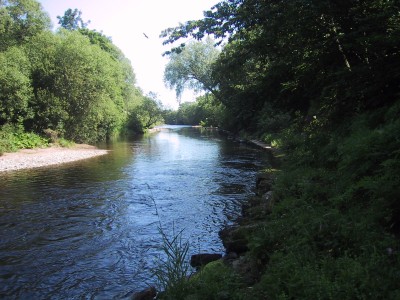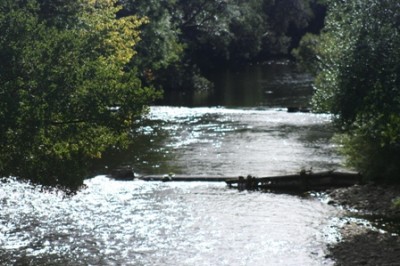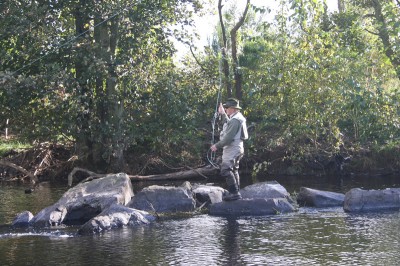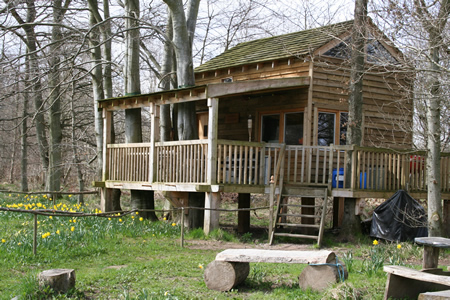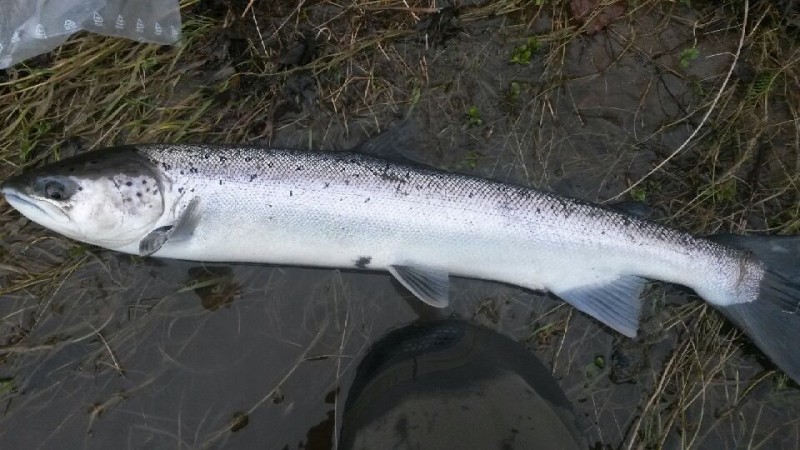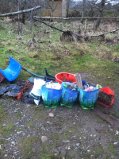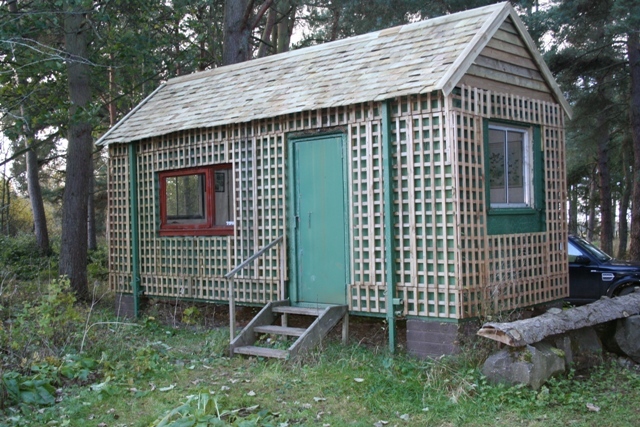FCW TEAM HAS A NEW TEAM MEMBER
Iain MacMaster comes from a well-known family of west coast gamekeepers. Introduced to the all-round delights of rivers and fishing by a fisherman father, Iain has told me that he is keen to learn the skills and gain the experience to become an a salmon and sea trout fishery guide & manager. As our readers will see from his blog that follows this introduction, Iain is already getting involved with all aspects of FCW – from greeting and advising visiting fishers to dealing with our horrendous outbreaks of giant hogweed. His description below, likening the task of achieving our zero-tolerance objective with GHW and other invasive species to WW11 knapsack spraying napalm in the humid jungle of Guadacanal, is very visual. The blog that follows is Iain’s first as an FCW team member. Wish him well, as we all do here at Finavon, and thank you Iain for infecting us with your enthusiasm – not to mention your hard work. TA
Red Brae & Kirkinn from the right bank – the heart of FCW
IAIN’S BLOG
The first thing that struck me when Tony led me down the Milton beat track last November, was the enchanting little wooden hut perched nobly above Craigo Stream. Stepping inside, I felt keenly that I was entering a sanctuary of memories and experiences. Over the mesmeric rush of the pool below, I could almost hear the whispered remnants of the conversations left by anglers past. Immediately, I sensed that here was a place which was loved and appreciated, not just by Tony, Alison and their family, but by many anglers from many places. The second thing that struck me was an almost overwhelming desire to be wading down the gravel shelf at Red Brae with my Bruce and Walker.
Since that day and the months following it, when I spent most of my days off-shift travelling to and working at Finavon, Tony and I have come a long way. I knew that I wanted to be involved with Finavon in a big way, and that desire grew just a little bit more every time that I came and went. So it didn’t take very long for Heather and me to start thinking about moving our life slightly North East…and here we are.
One of the first tasks which I undertook at FCW, back in those cold winter days was to harvest, trim and gather sheaves of willow canes. Anyone who fished at Finavon in the first month of the season, may remember seeing buckets full of them sitting outside every hut. I planted these in many of the soft edges up and down all four of the beats with the intention that the roots would take hold and help shore the banks up. Willow is fantastic stuff to plant, as you simply need to stick a cane into the ground where it will remain moist, and usually it will just grow. We seem to have had quite a successful take from the little wands, and once they grow bigger it will become necessary to keep them trimmed back so that they do their job without encroaching on casting space; which is always an issue with willow because it grows so quickly.
Beeches on Castle Beat, where Iain has done much of his work.
Since then, I’ve spent a lot of time planting other things too, Oak trees next to the Boat Pool, Honeysuckle around three of the huts, bird cherry scattered widely and Birches in a forest clearing adjacent to Harry’s Bar on Bogardo beat.
There have been many days spent chopping and trimming my way down the edges of various pools to open them up for easier fishing. It’s particularly satisfying to get to the bottom of a pool, look back upstream and see the difference that you’ve made. Beeches had this treatment at the beginning of the week and will now be much easier to fish effectively as the foliage on the North bank was really starting to impede when trying to form the loop of your roll cast. It is also possible to fish down the pool much more quietly now as you can wade it at ankle depth rather than knee depth, and stealth of course is of crucial importance when fishing for night time sea trout.
For the past couple of months the most important job has been dealing with the infestation of Giant Hogweed at FCW. This nasty plant from Asia was another ill-conceived introduction by the Victorians, who have a lot to answer for considering the proliferation of species such as Himalayan Balsam and Rhododendron as well. The attack on the Hogweed has been simple and brutal, carried out mostly by spraying the leaves directly with our new specially sanctioned herbicide which is completely non-toxic to mammalian or piscine life. One of the problems however has been that some of the seed heads were 10-12 feet high and probably 10 inches in diameter, so spraying the leaves wasn’t really an option. These sinister looking monsters have been hacked down with saws and billhooks and the herbicide has been sprayed directly down the hollow stems and into the root system. We’re hoping that this will utterly destroy the rhizomes.
I’ve been ending the day looking like a cross between a Pictish warrior of Finavon Hill and an Astronaut, thanks to the mixture of the blue dye from the spray, and the waders, overalls, gauntlets and safety goggles that I’ve been wearing! It has been a very hard and tiring task, but a very necessary one. It crossed my mind when stumbling and crawling with the heavy spray pack through the thickest of the dense cover that here was just a tiny flavour of what carrying a flame-thrower through the jungles of the Solomon Islands might have felt like! The spraying is still ongoing, but I’m confident that the worst of it is done. So if you happen to see any healthy looking thickets of Hogweed at Finavon, please do let Tony or myself know!
I’ve enjoyed meeting a lot of new and interesting people over the past eight months, and hopefully sown the seeds of some friendships too. I’ve been touched by the number of people asking for my input and advice, and I’ve been delighted to help out to the best of my ability. It has been a source of immense joy to me that some of this advice has even paid off with a fish for the odd angler. I’m always delighted to come and meet you when you’re fishing and try my best to help with any questions or needs you might have, so don’t hesitate to give me a shout when you come to FCW.
David’s Treehouse (DTH) at daffodil time.
Finavon is a magical and evocative place. You can’t help but think about the ancient Picts who must surely have fished those very same pools for the Salmon they so revered. And what history has been trodden upon those riverbanks? Did Pictish war bands follow the river on their way to the great battle of Dunnichen? Did Roman legionaries stop by the river to wash, drink and even fish on their way North? Finavon is more than just a place to come and fish for Salmon, it is utterly enchanting and I, like many others have fallen in love with it.
IMcM
